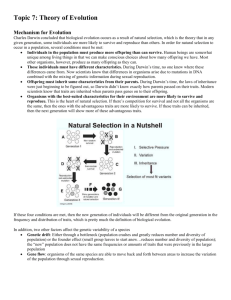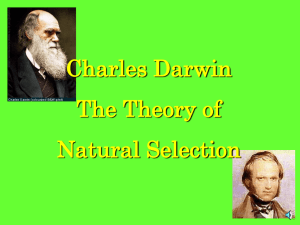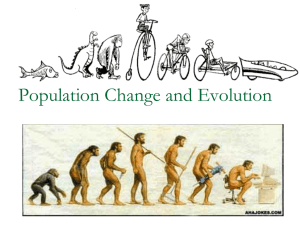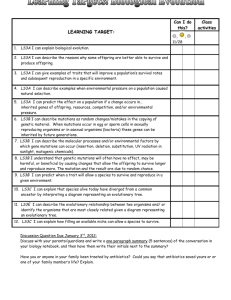Evolutionary Theory _Notes
advertisement
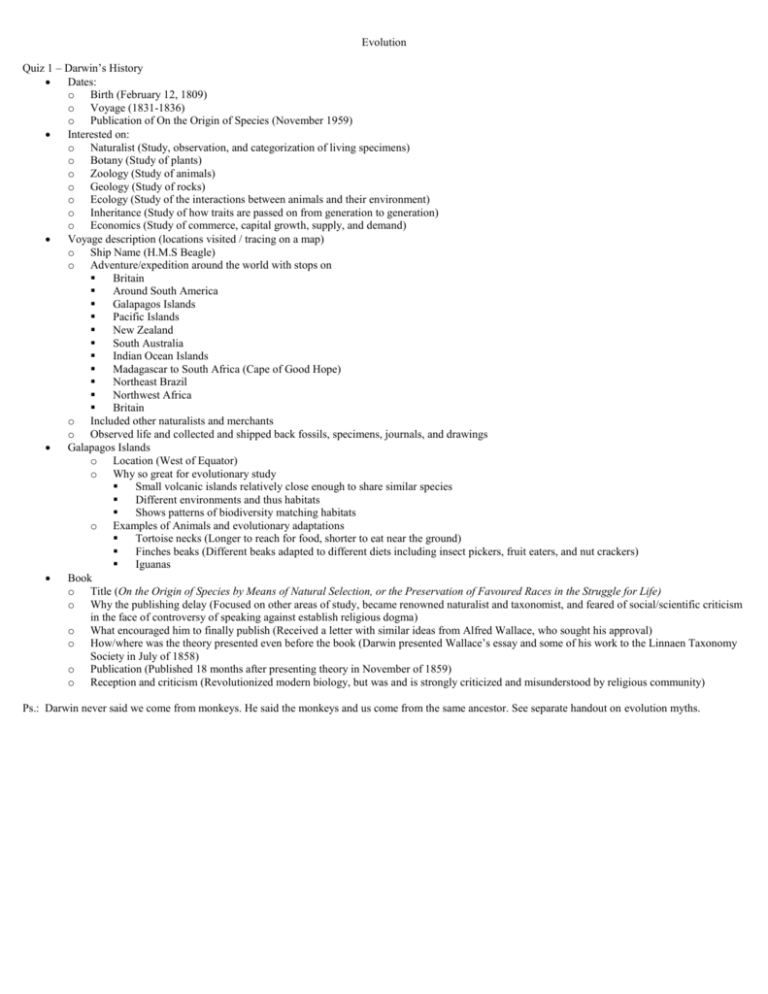
Evolution Quiz 1 – Darwin’s History Dates: o Birth (February 12, 1809) o Voyage (1831-1836) o Publication of On the Origin of Species (November 1959) Interested on: o Naturalist (Study, observation, and categorization of living specimens) o Botany (Study of plants) o Zoology (Study of animals) o Geology (Study of rocks) o Ecology (Study of the interactions between animals and their environment) o Inheritance (Study of how traits are passed on from generation to generation) o Economics (Study of commerce, capital growth, supply, and demand) Voyage description (locations visited / tracing on a map) o Ship Name (H.M.S Beagle) o Adventure/expedition around the world with stops on Britain Around South America Galapagos Islands Pacific Islands New Zealand South Australia Indian Ocean Islands Madagascar to South Africa (Cape of Good Hope) Northeast Brazil Northwest Africa Britain o Included other naturalists and merchants o Observed life and collected and shipped back fossils, specimens, journals, and drawings Galapagos Islands o Location (West of Equator) o Why so great for evolutionary study Small volcanic islands relatively close enough to share similar species Different environments and thus habitats Shows patterns of biodiversity matching habitats o Examples of Animals and evolutionary adaptations Tortoise necks (Longer to reach for food, shorter to eat near the ground) Finches beaks (Different beaks adapted to different diets including insect pickers, fruit eaters, and nut crackers) Iguanas Book o Title (On the Origin of Species by Means of Natural Selection, or the Preservation of Favoured Races in the Struggle for Life) o Why the publishing delay (Focused on other areas of study, became renowned naturalist and taxonomist, and feared of social/scientific criticism in the face of controversy of speaking against establish religious dogma) o What encouraged him to finally publish (Received a letter with similar ideas from Alfred Wallace, who sought his approval) o How/where was the theory presented even before the book (Darwin presented Wallace’s essay and some of his work to the Linnaen Taxonomy Society in July of 1858) o Publication (Published 18 months after presenting theory in November of 1859) o Reception and criticism (Revolutionized modern biology, but was and is strongly criticized and misunderstood by religious community) Ps.: Darwin never said we come from monkeys. He said the monkeys and us come from the same ancestor. See separate handout on evolution myths. Quiz 2 – History of Evolutionary Thought Match scientists to theories (some might have multiple theories and some theories might go with multiple scientists) Describe each theory Create a time line showing the sequence of the development of the modern evolutionary thinking List geology concepts that affected the development of evolutionary theory List Lamark’s hits/misses Scientists / Philosophers (ordered by date) Aristotle / Plato (Naturalist / Fixed Creationism / Arrangement of life by Complexity and Habitat) Linnaeus (Taxonomy / Binomial Nomenclature / Naturalist) James Hutton (Geology / Paleontology / Gradualism) John Baptist Lamarck (Naturalist / Ecology / Evolution / Law of Use and Disuse / Inheritance of Traits / Paleontology / Thomas Malthus (Economist / Population Dynamics / Ecology) Georges Cuvier (Naturalist / Ecology / Geology / Paleontology / Catastrophism) Charles Lyell (Geology / Uniformitarianism) Charles Darwin (Naturalist / Taxonomy / Ecology / Evolution Paleontology / Common Ancestry / Struggle for Existence / Inheritance Across Generations / Natural Selection) Alfred Russell Wallace (Naturalist / Ecology / Evolution / Common Ancestry / Struggle for Existence / Inheritance Across Generations) Gregory Mendel (Naturalist / Inheritance of Traits / Particle Inheritance) Theories Arrangement of life forms by complexity and habitat (Classification by where you live and what you can do) Binomial Nomenclature (Scientific naming using genus and species in latin/greek) Catastrophism (Animals go extinct when they cannot cope with rapid environmental changes) Common Ancestry (New species come from other species and organisms share common ancestors) Ecology (Study of the interactions between animals and their environment) Evolution (Change in populations over period of time, usually a long time and over many generations) Fixed Creationism (Organisms created as they are. Have remained the same “form” since the beginning. No new organisms arise) Geology (Study of rocks) Gradualism (Earth is old and ever changing) Inheritance of Acquired Characteristics (Incorrect principle that organisms inherit traits acquired from parents after learning and coping with environmental pressures) Inheritance of Traits (Traits are passed on across generations from progenitors to offspring) Law of Use and Disuse (Incorrect principle that states that while traits which are useful and are used often become more common, traits which are not useful or are not used, become less common across generations – Not quite how it works) Natural Selection (Process by that governs evolution: changes in the population result when natural pressure due to limited resources force competition between organisms and those who are fittest, or have better sets of adaptions, survive longer, reproduce more often, and have more offspring that does the same, and thus become more common in the population, which in turn, changes overtime) Naturalist (Study, observation, and categorization of living specimens) Paleontology (Study of fossils) Particle Inheritance (Genetics or the study of how inheritance is controlled by combinations of particles called genes) Population Dynamics / Ecology (Study of population growth and limiting factors) Population Genetics (Study of how genetic inheritance patterns of populations change over time) Struggle for Existence (Animals compete for access to limited nutrients and resources) Taxonomy (Classification in groups by similarities in features) Uniformitarianism (Earth has changing through similar and predictable ways for a long time) Lamark’s Hits: Inheritance of traits across generations Gradual change over many generations leads to evolution of new species Changes have something to do with what is beneficial to organism in a particular environment or what it has to do to survive Lamark’s Misses: Tendency Towards Perfection o Organisms do not get better. There is no better in genetics. What is good now is bad later or somewhere else) Acquired Characteristics o Organisms learning is not genetically passed on Law of Use and Disuse o Organisms adapt structures and behavior in response to environment, but this learning does not get genetically passed on o Offspring does not automatically inherit learning or features achieved environmentally by parent o Disuse does not necessarily mean that phenotype will disappear (it must be disadvantageous) o Use does not necessary mean that phenotype will become more common (it must be advantageous) No understanding of patterns of inheritance, particle theory of genetics, or molecular genetics o Somatic mutations cannot be passed on. o Only gametic mutations (which would not change parent) cause evolution o Mutations are random events that do not depend on the environment (even if caused by environmental factors such as radiation or chemicals, they do not cause specific results but randomly damage/alter the genetic code) Quiz 3 – Principles Upon Which Evolution is Based on Geology & Evolution Earth is Ancient Earth is always gradually changing Earth processes occur at uniform rates Species often do not survive earth changes Ecology & Evolution Basics o Ecology (Study of the interactions between animals and their environment) o Evolution (Change in populations over period of time, usually a long time and over many generations) o Generation (A group of offspring born from one or many parents around the same period of time) o Progeny/Offspring (Children or outcome of reproduction) o Progenitors/Parents (Generators of offspring or organisms reproducing) o Species (A specific type of organism; Members of the same species can reproduce viable, fertile offspring over generations) o Population Size (Total Number of organisms of a species living in a certain area) o Population Density (Average number of organisms per unit of area) o Birth rate (Number of new offspring in a certain period of time) o Death rate (Number of organisms dying over a certain period of time) o Migration (Organisms moving across habitats) o Immigration (Organisms entering an area) o Emigration (Organisms leaving an area) o Carrying capacity (Total number of organisms that can be supported in a certain habitat) Population Growth o Linear Growth (Pattern of growth marked by the “addition” of the same number offspring with each generation) o Exponential Growth (Pattern of growth marked by the “multiplication” of offspring by a certain factor with each generation) o Logistic Growth (Pattern of growth marked by exponential growth limited by environmental factors, or a carrying capacity) Populations would tend growth exponentially if they could (as long as birth rates + immigration > death rates + emigration) Populations depend on their environment for survival o Nutrients (Required for survival (water, energy, food) o Resources (Assist survival (shelter, mates, etc.) o Habitat (Location on ecosystem inhabited by an organism) o Niche (Role of the organism in the environment as well as the specific things from the environment it depends on) Population growth is hindered by limiting factors that determine the environment’s carrying capacity o Density dependent factors (Factors that depend on numbers of organisms are in the population) Competition (Organisms fighting for nutrients and resources, which increases with population size) Predation (Organisms eating others for energy) Predators spot larger populations easier, but members of the population have greater chances of survival Number of predators and prey depend on each other. If there is more prey than predators, predators can eat more and multiply, which then reduces number of prey and consequentially number of predators. If there are more predators than prey, predators starve and decrease in numbers allowing prey to increase, which consequentially allows for more predators. Disease/Parasitism: Organisms succumbing to sickness or parasites (the greater the population size, the faster disease/parasites spread) o Density independent factors (Factors that do not depend on number of organisms on the population) Catastrophes (Natural disasters kill large or small populations the same way. Though large populations have greater chances of having at least a few members left, chances of death are the same) Habitat destruction (Loss of resources kills large or small populations alike) Genetics & Evolution Variation (There is diversity within and between species caused by random mutations) Mutations (Changes in genetic structure) Neutral Mutations (Mutations that do not change the organisms structure or behavior) Neutral Variations(Mutations that change the organism structure or behavior, without causing and advantage or disadvantage) Adaptations (Variation that increases chances of survival are called adaptations) o Physical Adaptation (Advantages based on structural variation, such as body parts, camouflage, warning coloration, etc.) o Behavioral Adaptation (Advantages based on action-patterns, such as migration, hibernation, hunting, grazing, herding, etc.) Inheritance (The passing on of traits from generation to generation) Quiz 4 – Darwin’s Theory of Evolution Darwin’s Basic Observations during voyages (3) Patterns of Biodiversity Unique adaptations lead to variation BETWEEN and WITHIN species Uneven distribution of species in space and time Examples of Physical Evidence Collected by Darwin (3) Live or Preserved Specimens Fossils Drawings Darwin’s Assumptions (3) Populations would increase exponentially if left unchecked Population growth is hindered by limiting factors Environmental resources are limited Darwin’s Conclusions (4) Animals must struggle to survive against other species and members of their own species Only a fraction of offspring survive Animals with best set of adaptations (fittest) will live longer, reproduce more often, and have offspring that does the same Over time features of fittest animals become more common in the population thus leading to its gradual change an evolution Since this is tied to the environment, which changes with location and time, different animals exist in different places and eras of Earth General Principles (5) Populations NOT species evolve Fitness is based on more adaptations, greater survival, more offspring, and offspring success Speciation is the process by which new species comes from older species. All organism descent from other organisms with modifications. The implication of descent with modification is that all life on Earth shares common ancestry Criticism (3) Social: Strong opposition because of impact on religious dogma Scientific: Did not provide mechanism for origin of variation (No genetics: random mutations not understood at the time) Historic: He may have gotten some his ideas form Wallace (though journal entries describing his theory predate his receiving Wallace’s letter) Evidence (6) Anatomy o Homologous Structure (Similar structures in different animals indicating common ancestry) o Analogous Structures (Similar structures in animals that do not share an ancestor since the evolution of the trait, but who live under in similar environmental pressures) o Vestigial Structures (Structures that longer serve an evolutionary purpose but are remnants of previous evolutionary steps) o Mosaic Structures (Structures that evolve for one purpose but are used for another) Embryology (Study of embryo formation and development) o Similarities in Embryonic Development (related animals share embryonic stages) Molecular Biology (Study of biological molecules) o DNA similarities (Related animals share DNA code) Microbiology & Field Biology o Microevolution of virus and bacteria (example: drug-resistance) o Animal microevolution and selection in response to human induced habitat change (Example: White vs. Gray moth) Fossil Record (Geological evidence of extinction of old species and appearance of new species) Parsimony (When different theories are proposed the simplest explanation that fits the data is accepted. Currently no other theory explains the evidence collected as well as evolutionary does) Biogeography (Patterns in geographical distribution of species) o Microbiology (study of bacteria and protists) o Virology (study of viruses) o Mycology (study of fungi) o Botany (Study of plants: flora) o Zoology (Study of animals: fauna) Types Evolutionary Gradualism vs. Punctuated Equilibrium (Evolution in slow vs. sudden changes) Convergent vs. Divergent (Animals share features because of common ancestor as seen through homology vs. Animals look similar because of similar selective pressures as seen through analogy) Microevolution vs. Macroevolution (Small scale evolution of a population vs. large scale evolution of entire ecosystems)


